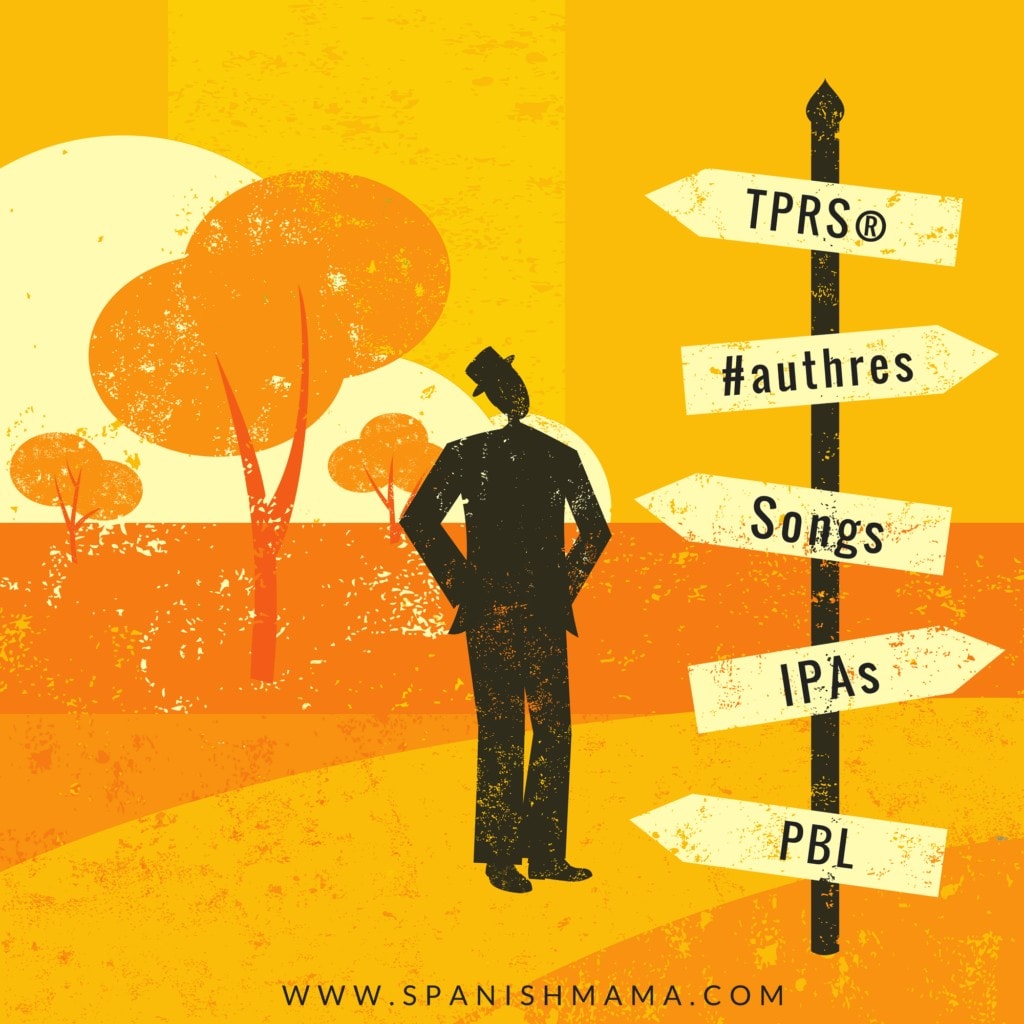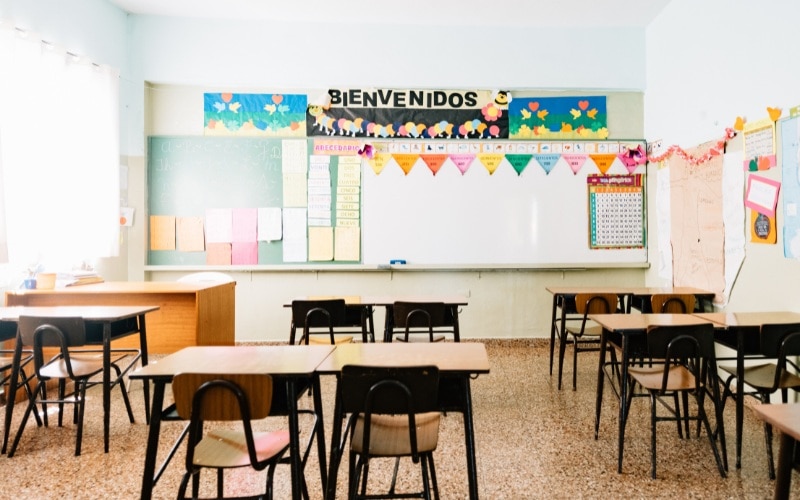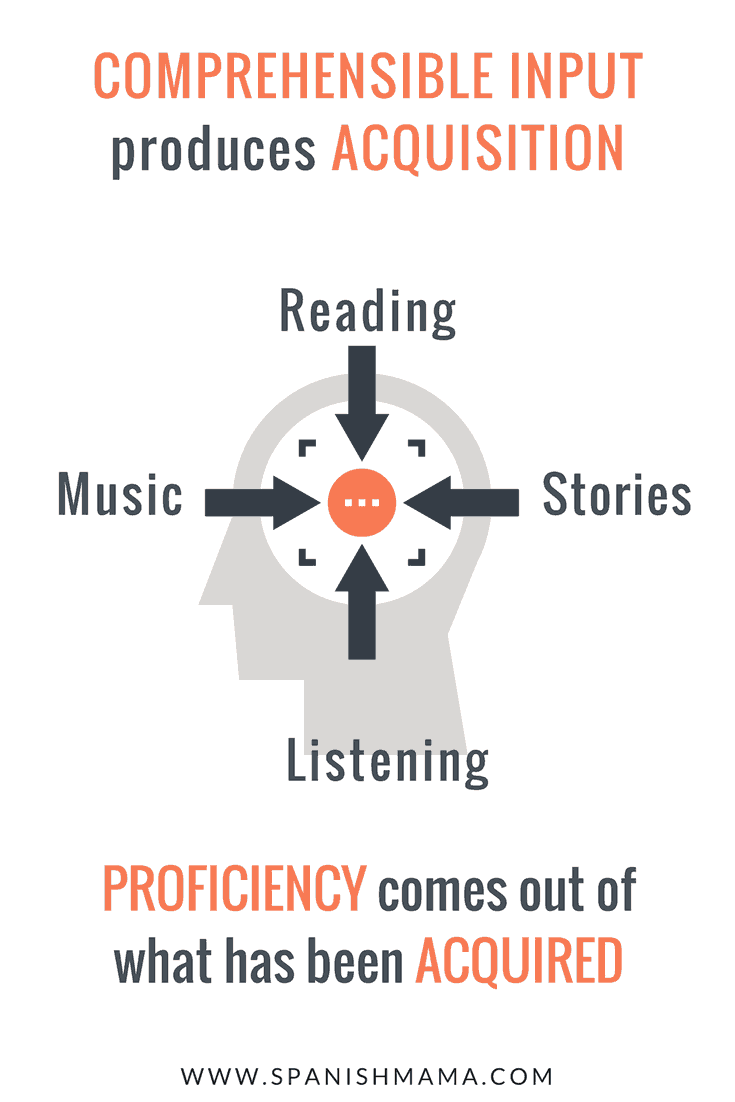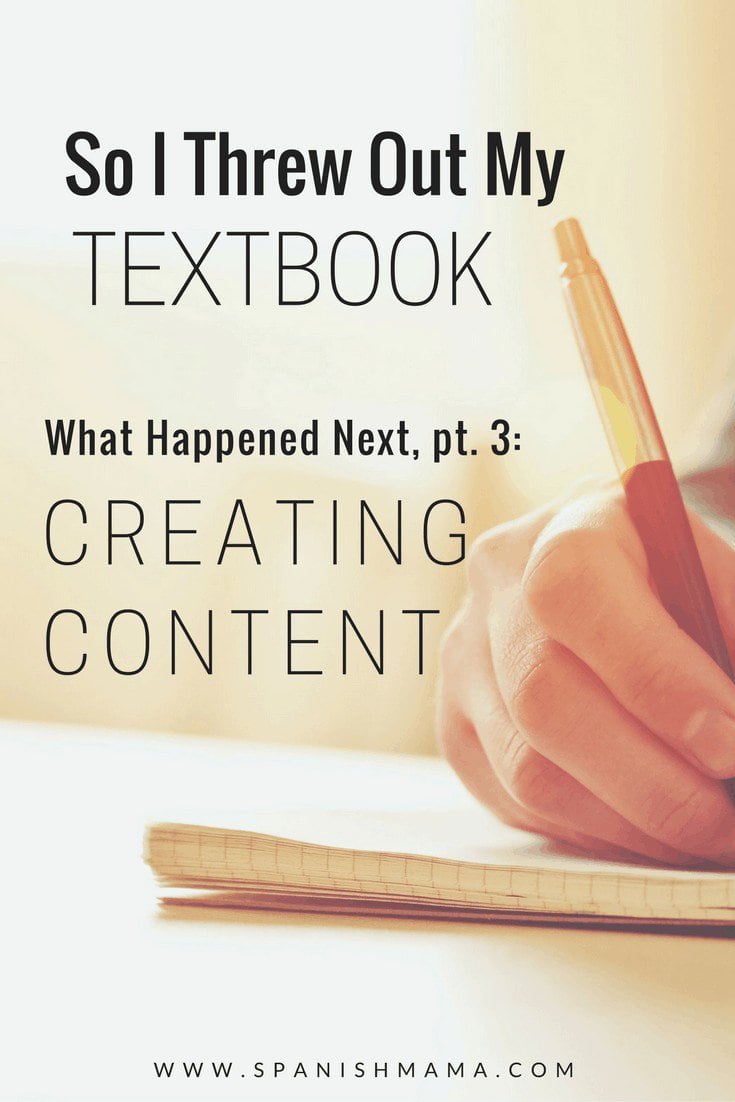How to Teach Spanish Without a Textbook: 11 Strategies that Work
Inside: How to teach Spanish without a textbook– finding strategies that really work.
When I got rid of my Spanish textbook, I wanted to jump right into planning. Just tell me what to do, on a day-to-day basis, please!
The WHY has to come first, though. Even really good materials can go wrong if the teacher doesn’t know WHY she’s doing what she’s doing. So I spent a lot of time studying up on HOW students learn language and WHERE we were going as a class.
Once you have that down, it’s finally time to look at methods, materials, and strategies. If you are using a textbook, these are still some really great ways to supplement and bring your books to life.

When I looked at what was out there, I felt lost in a sea of acronyms. Everyone seemed to be preaching his or her method, and showing off the student success I yearned for. Was TPRS® the only right way? Should I spend my summers hunting down authentic resources? And really– is an IPA a beer or an assessment?
This post takes a tour through the big buzzwords in teaching language. Some of these are entire methods, and others are simple strategies.
Contents:
1. What is CI?
2. TPRS
3. Authentic Resources
4. Novels
5. PQA
6. MovieTalk
7. Persona Especial
8. Story Listening
9. IPAs
10. OWIs
11. OWL
It’s tempting to join a FB group, hear all the awesome things other teachers are doing, and want to do EVERYTHING, right now. My advice is to read up, and choose two or three strategies to begin with. Start there, and observe how it goes.
What brings life to your class? What satisfies your school requirements? What do you love to do? What is realistic?
As you research, ask two questions about any method/strategy/activity:
1) Does it provide compelling, comprehensible input?
2) Does it efficiently support growth in proficiency?
Activities that answer “YES” should be the meat of your day.
Under that criteria, I dropped a lot of traditional work: out-of-context vocab lists, isolated grammar drills, projects that looked pretty but didn’t result in proficiency growth, etc. (Caveat: Some of you have requirements to teach explicit grammar, or a certain way. Obviously, work with your standards.)
As a fellow beginner, I’d like to run down the list of popular methods and acronyms, give my opinion if I have one, and then point you to the experts I trust. If something resonates with you– AND supports proficiency/provides good input– start there. Some of these are little pieces of teaching and assessing language, and some are entire methods.Teaching to ProficiencyWhat is teaching to proficiency in the language classroom?
HOW TO TEACH SPANISH: FINDING YOUR WAY AMONG THE ACRONYMS AND STRATEGIES
1. CI
It’s important to note that Comprehensible Input is not a strategy or method. CI is a thing: messages that students understand. Through CI, our students acquire language.
Example: Instead of explaining the verb ser, a CI teacher would provide a text or conversation that uses ser in context. After seeing es or soy in various real contexts, they will begin to acquire ser and produce it in a natural way.
CI is a big topic that doesn’t fit well into a few paragraphs, so here’s my deep dive: What is Comprehensible Input? A Beginner’s Guide
There are different ways of providing CI. Even a grammar textbook will incorporate a tiny amount of CI. El libro es grande. It’s just usually limited, out of context, and kinda dry.
The best CI is language our students understand and are interested in. Our job as teachers is to ask: what activities provide the best input? What is interesting to my students?
When I started to calling myself a “CI Teacher,” it really meant: I believe that students acquire language through comprehensible input. Therefore, I now employ strategies that maximize exposure to quality CI (my favorites are TPRS®, MovieTalk, authentic music, and novels.)
To see how one teacher puts these different strategies together to structure her curriculum, check out Mis Clases Locas’ curriculum map for Spanish 1-4.
2. TPRS®
Teaching Proficiency through Reading and Storytelling® is a collaborative method of storyasking, between the teacher and the class, and originally created by Blaine Ray.
I rely on it heavily, though not exclusively or strictly. I found that by using student actors and creating a memorable story, the structures stuck. As in, I almost completely eliminated vocabulary quizzes, grammar exercises, and homework, with better results.
Many people picture it as a marathon of ridiculous stories, or repetitive questions. It can be, but it doesn’t have be. I highly recommend familiarizing yourself with TPRS and doing a training, before you rely on hearsay or one impression to make the decision. Many other techniques utilize and build on the skills you’ll acquire through TPRS.
For Spanish 1 and 2, I story-ask about once or twice week unless we’re in a novel unit. It’s an exhausting day, but the stories remain so vivid that the follow-up activities, discussions, and readings usually go well.
Deep dive: TPRS: A Beginner’s Guide to Storytelling
Read & see more:
How to ask a story.from Martina Box
What I Love About TPRS by Musicuentos
See an example of a unit built around storyasking once a week, from Martina Bex.
3. #AUTHRES
Authentic resources are materials from native speakers meant for native speakers, not learners. I LOVE a good authentic resource when I can find one. My absolute favorite is authentic songs or video clips that coincide with structures we’re learning.
Where I differ from the #authres movement is the assumption that authentic is always better, or that students will learn better Spanish. I am cautious when I hear of schools trying to base everything they do on authentic resources.
For upper-level classes, they are incredibly useful. For novices, it depends. I think #authres are best used when the end goal is very clear. For example, if I want the students to acquire Spanish efficiently, I’ll grab a novel written for students. If I want them to feel the thrill of reading a “real” Spanish text or work on finding the main idea, I’ll give them an authentic reading.
Too much dependence on #authres: Students acquire less. They have good real-word skills of finding the main idea, or recognizing vocabulary, but fewer internalized structures.
Too little exposure to #authres: students are frustrated that in real life that everything isn’t comprehensible. They are give up easily or lack the confidence to persevere in confusing situations.
Creative Language Class is an amazing resource for centering your lessons on #authres.
How to Find #authres on Social Media from Secondary Spanish Space
Authentic Resources vs Learner Materials from Musicuentos
Authentic Songs for Spanish 1, Spanish 2, and Advanced Spanish Classes
4. NOVELS
My favorite way to teach Spanish is through novels created for earners. There’s huge selection available at Fluency Matters. You can develop a months-long unit based on the novel that incorporates culture and history, and read together as a class. Novels are also perfect for FVR (Free Voluntary Reading) or SSR (Sustained Silent Reading), and I often start class with 10 minutes of SSR/FVR.
Why You Should Teach with Novels
Fluency Matter Novels
Teaching with Novels 101 from Secondary Spanish Space
How Should I Use Novels in Class? from Martina Bex
5. PQA
Personalized Question and Answering is as old as the hills: talking with your students, about them and things that interest them. I had tried my hand at it from the beginning, but after seeing it done as a TPRS skill, I learned more how to make it comprehensible and compelling. It can be a way to create input around target structures leading into a story, and some skillful teachers can spend an entire period on PQA.
PQA is very simple and effective: ask students about themselves. Center the conversation on them. It gets in many reps, and is usually high-interest.
How to Do PQA from Susan Gross
PQA in a Wink from Ben Slavic
PQA My Way from Alina Filipescu
6. MOVIETALK®
MovieTalk is another TPRS technique for delivering CI. I LOVE it. MovieTalk is basically narrating a video clip through comprehensible language. The teacher narrates the story, pauses, points, and ask questions as necessary.
I actually like it better than storytelling, because it’s so compelling and you don’t have to come up with the story on your own.
Deep Dive: What is MovieTalk?
After the MovieTalk, you can give readings of the story or do extension activities. I choose MovieTalks that show structures we’re learning and lend themselves to what we know.
See an example from Adriana Ramirez:
7. Persona Especial
Persona Especial is a high-interest way to put a student in the spotlight and get to know them. It’s essentially a series of interviews that the teacher does with individual students, in front of the whole class. The idea is to find out more about that student and get to know them, while staying in the target language and keeping it comprehensible.
Deep Dive: Persona Especial Interviews 101
Persona Especial was originally formulated and brought to the language teaching community by Bryce Hedstrom, who explains his process for interviews on his site.
8. STORY LISTENING
I am totally new to story listening, but I’m intrigued. Here’s a video demonstration from Beniko Mason:
And here’s the website to read more about the SL method. I like that this method focuses on great, classic stories. One of my criticisms of TPRS has been that it seems to be silly, crazy stories all the time. That’s fun, and effective, but it seemed to be missing the component of filling our students beautiful, good texts. Perhaps this is the missing key? I haven’t wrapped my head around non-targeted input, though, and how it would work to do this full-time.
10. IPAS
Integrated performance assessments reflect the ACTFL standards. They measure interpretive reading, interpretive listening, presentational writing, presentational speaking, and interpersonal communication. Instead of parsing sentences and conjugating verbs, the students interpret and respond to authentic resources.
In Spanish 1, I diverged a bit from my mainly-TPRS track to do a unit on food. My students travel sometimes or eat a Latino restaurants, and a themed food unit would help them be ready for real-life interactions. I decided to backwards design from an IPA at the end of the unit, in which we would read authentic restaurant menus and watch YouTube videos of recipes made by native speakers. Months after, I had students report back how they’d ordered for their whole family in Mexico, pleased as pie with themselves.
In this case, although I incorporated CI through readings and stories, I was deliberately targeting other skills. We used lots of authentic resources because the goals went beyond just acquisition: we were developing skills of getting the main idea from reading and listening to native speakers.
I am on the fence about IPAs, though that may be because I haven’t been trained to use them. I think they’re far better than grammar-based tests. They do a great job of prepping for Spanish in the real world. They tend to produce confident students with real-world skills.
On the other hand, IPAs are a lot of work without being entirely authentic. The interpersonal section doesn’t reflect speaking with a native, and the #authres are still weeded through carefully, to find resources that are fairly understandable and appropriate. I feel like my free-writes or tests on learner materials (which are way less work on my end) give me an equally good sense of their proficiency levels. I think IPAs can be really great, as long as you are careful to provide rich input, and not just teach to the test.
IPAs with Jen Shaw Jen is fantastic and will be so helpful for beginners.
Examples of IPAs
Seven Steps to Creating an IPA from Madame Shepard
11. OWI
Haven’t done One Word Images personally. Check out the videos below for more:
12. OWL
OWL (Organic World Language) sounds amazing!– but I am not sure how to find out much information aside from attending a training directly from the organization (which I haven’t done). I do know it uses 100% TL, and tons of games, interactive activities, and movement. Several bloggers I follow incorporate OWL into their teaching:
La Maestra Loca
World Language Classroom
Organic Language Learning
13. PBL
I know nothing about Project-Based Learning, but Laura at PBL in the TL does!
Like it? Pin it!









Thank you SOOO much for this post! I feel like I have been swimming in a vast ocean of methods, ideas , activities , etc. for years and cannot seem to put my finger on anything specific to give me the right direction. You’ve really sorted things out for me.!
It’s sooo confusing, I agree!! And I’m sure in a year there will be new ideas to add. 🙂
Thank you so much for the tips!! In college I was always taught to believe #authres and IPA’s were the only way to go, but I am glad we can recognize the shortcomings even those methods have. That was very insightful. Also, I just think it’s better to have a mix of methods when possible!
I’m so glad! It’s a lot to sort through, and there’s always new info coming out.
Thank you so much for providing these resources. I am honestly lost as a lateral entry Spanish teacher and often times teach the way I was taught (textbook + workbook!). You provided a pathway for change when a lot of other language teachers intimidate in how “together” their teaching seems. I often feel like many of these teachers have tons of resources when my county pretty much buries foreign language in a hole labeled ‘requirement’ and ‘elective’. I just need some direction and support! Thank you.